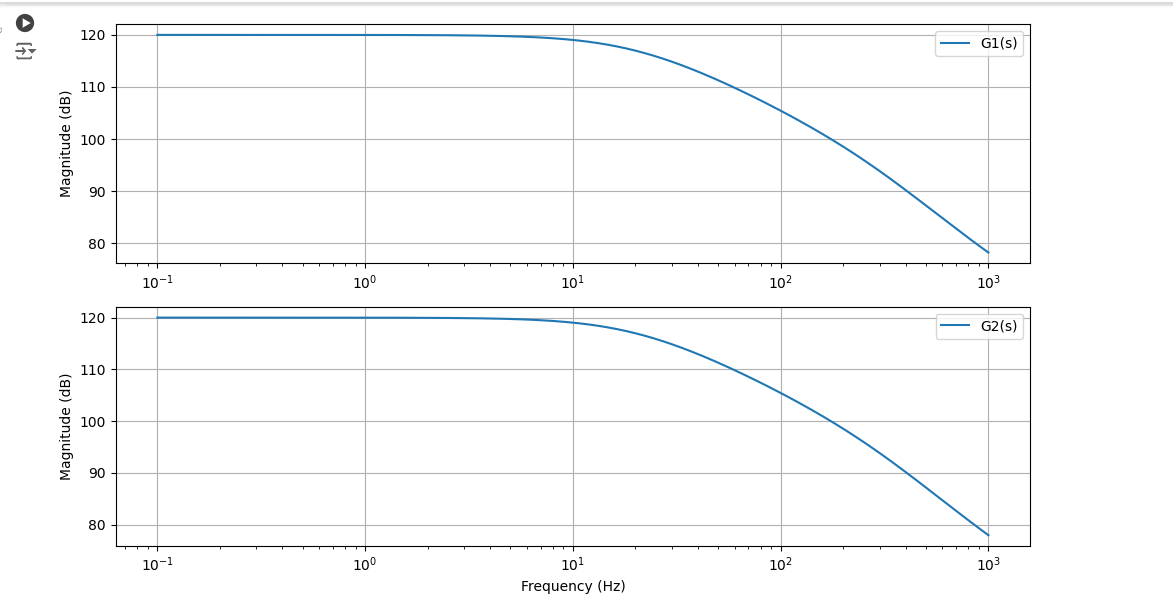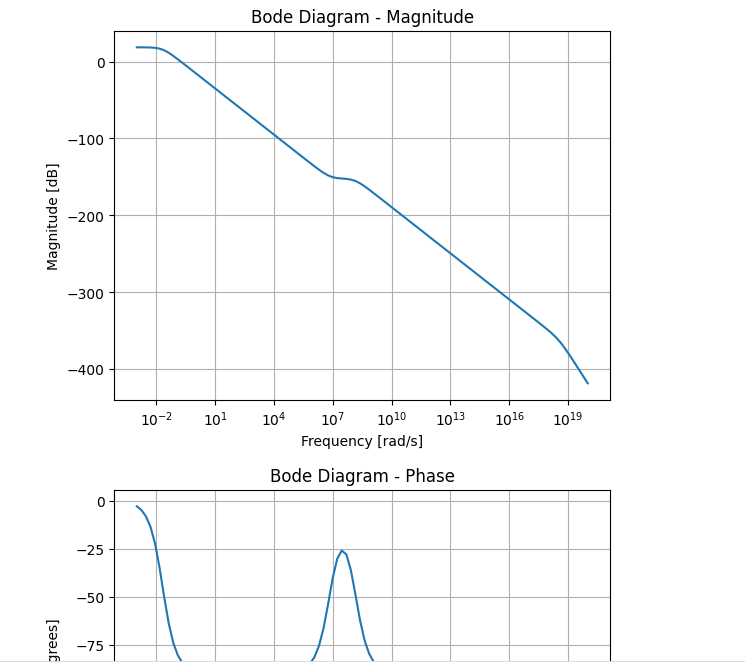P20~23
ID=IDsat×(1+λVDS)
IDsat=(1/2)μ×Cox×(W/L)(VGS-Vth)^2
VGS=√(ID/((1/2)×μ×Cox×(W/L)))+Vth
import math
def calculate_IDsat(mu, Cox, W, L, VGS, Vth):
return 0.5 * mu * Cox * (W / L) * (VGS - Vth)**2
def calculate_ID(mu, Cox, W, L, IDsat, lambda_VDS):
return IDsat * (1 + lambda_VDS)
def calculate_VGS(ID, mu, Cox, W, L, Vth):
return math.sqrt(ID / (0.5 * mu * Cox * (W / L))) + Vth
# Parameters (example values)
mu = 200e-6 # Mobility in cm^2/(V·s)
Cox = 1e-8 # Oxide capacitance per unit area in F/cm^2
W = 10e-6 # Width in meters
L = 1e-6 # Length in meters
Vth = 1 # Threshold voltage in volts
lambda_VDS = 0.02 # Channel-length modulation parameter
# Example VGS value
VGS = 1.8 # Gate-source voltage in volts
# Calculations
IDsat = calculate_IDsat(mu, Cox, W, L, VGS, Vth)
ID = calculate_ID(mu, Cox, W, L, IDsat, lambda_VDS)
calculated_VGS = calculate_VGS(ID, mu, Cox, W, L, Vth)
# Output the results
print(f"IDsat: {IDsat} A")
print(f"ID: {ID} A")
print(f"Calculated VGS: {calculated_VGS} V")
P30
I=VDD/R1-VOUT/R1
横軸VOUT 縦軸I
import numpy as np
import matplotlib.pyplot as plt
# Define the parameters
VDD = 5.0 # Supply voltage in volts
R1 = 1e3 # Resistance in ohms
# Define the range for VOUT
VOUT = np.linspace(0, VDD, 500) # 500 points from 0 to VDD
# Calculate the current I
I = (VDD - VOUT) / R1
# Plot the results
plt.figure(figsize=(10, 6))
plt.plot(VOUT, I, label='Current I vs VOUT', color='blue')
plt.xlabel('VOUT (V)')
plt.ylabel('I (A)')
plt.title('Current I vs VOUT')
plt.grid(True)
plt.legend()
plt.show()
P107
gm1=μ×Cox×(W/L)(VGS-Vth)
gm2=√(2× μ×Cox×(W/L)× IDsat)
IDsat=(1/2)μ×Cox×(W/L)(VGS-Vth)^2
import math
# Constants and parameters
mu = 1e-4 # Mobility (example value)
Cox = 1e-8 # Oxide capacitance per unit area (example value)
W = 1e-6 # Width of the MOSFET (example value)
L = 1e-6 # Length of the MOSFET (example value)
VGS = 1.0 # Gate-source voltage (example value)
Vth = 0.2 # Threshold voltage (example value)
# Calculate gm1
gm1 = mu * Cox * (W / L) * (VGS - Vth)
# Calculate IDsat
IDsat = 0.5 * mu * Cox * (W / L) * (VGS - Vth) ** 2
# Calculate gm2
gm2 = math.sqrt(2 * mu * Cox * (W / L) * IDsat)
# Display the results
print(f"gm1 = {gm1:.3e} S")
print(f"gm2 = {gm2:.3e} S")
print(f"IDsat = {IDsat:.3e} A")
P109負荷アンプ回路
-gm×(出力抵抗1×出力抵抗2)/(出力抵抗1+出力抵抗2)
import numpy as np
# Define the parameters
gm = 1e-1 # Transconductance in Siemens
R1 = 1 # Output resistance 1 in ohms
R2 = 2e10 # Output resistance 2 in ohms
# Calculate the gain
gain = -gm * (R1 * R2) / (R1 + R2)
# Convert the gain to decibels (dB)
gain_dB = 20 * np.log10(abs(gain))
# Display the results
print(f"Gain: {gain}")
print(f"Gain in dB: {gain_dB}")
P121
2段増幅CMOSアンプ位相補償回路
import numpy as np
import matplotlib.pyplot as plt
from scipy import signal
# Given parameters (example values, replace with actual values)
gm1 = 35e-6 # Given in micro (μ)
gm6 = 23e-6 # Given in micro (μ)
R1 = 50e6 # Given in ohms
R2 = 25e6 # Given in ohms
Cc = 1 # Replace with actual value if different
Rc = 1 # Replace with actual value if different
# Frequencies (in rad/s)
wp1 = 2 * np.pi * 2.88
wp2 = 2 * np.pi * 1.8e6
wp3 = 2 * np.pi * 965e3
wzA = 2 * np.pi * 2.8
wzB = 2 * np.pi * 22e6
# Transfer functions G1 and G2
num1 = [-wzA, 1] # Numerator of G1
den = np.polymul([1/wp1, 1], np.polymul([1/wp2, 1], [1/wp3, 1])) # Denominator common for both
num2 = [1/wzB, 1] # Numerator of G2
# Construct transfer functions
G1 = signal.TransferFunction(num1, den)
G2 = signal.TransferFunction(num2, den)
# Frequency range for Bode plot
w = np.logspace(0, 8, 1000)
# Calculate the product gm1 * gm6 * R1 * R2
product = gm1 * gm6 * R1 * R2
# Convert product to decibels
product_db = 20 * np.log10(product)
print(f"The product gm1 * gm6 * R1 * R2 is: {product:.4e}")
print(f"The product in dB is: {product_db:.2f} dB")
# Bode plot for G1 and G2 combined
plt.figure(figsize=(10, 8))
# Bode plot for G1
plt.subplot(2, 1, 1)
w, mag1, phase1 = signal.bode(G1, w)
plt.semilogx(w, mag1, label='G1')
plt.title('Bode plots of G1(s) and G2(s)')
plt.ylabel('Magnitude (dB)')
plt.grid(which='both', axis='both')
plt.legend()
plt.subplot(2, 1, 2)
plt.semilogx(w, phase1)
plt.ylabel('Phase (degrees)')
plt.xlabel('Frequency (rad/s)')
plt.grid(which='both', axis='both')
# Bode plot for G2
plt.subplot(2, 1, 1)
w, mag2, phase2 = signal.bode(G2, w)
plt.semilogx(w, mag2, label='G2')
plt.ylabel('Magnitude (dB)')
plt.grid(which='both', axis='both')
plt.legend()
plt.subplot(2, 1, 2)
plt.semilogx(w, phase2)
plt.ylabel('Phase (degrees)')
plt.xlabel('Frequency (rad/s)')
plt.grid(which='both', axis='both')
plt.tight_layout()
plt.show()
import numpy as np
import matplotlib.pyplot as plt
# Define the parameters
B = 1000
C = 20
D = 300
E = 4000
# Define the transfer functions G1(s) and G2(s)
def G1(s, A):
return A * (1 - s/B) / ((1 + s/C) * (1 + s/D))
def G2(s, A):
return A * (1 + s/B) / ((1 + s/C) * (1 + s/D) * (1 + s/E))
# Calculate Bode magnitude in dB for G1(s) and G2(s)
def calculate_bode_plot(A_G1, A_G2):
omega = np.logspace(-1, 3, 1000)
s = 1j * omega
mag_G1 = 20 * np.log10(np.abs(G1(s, A_G1)))
mag_G2 = 20 * np.log10(np.abs(G2(s, A_G2)))
return omega, mag_G1, mag_G2
# Plot Bode plots for G1(s) and G2(s)
def plot_bode(A_G1, A_G2):
omega, mag_G1, mag_G2 = calculate_bode_plot(A_G1, A_G2)
plt.figure(figsize=(10, 6))
# Bode plot for G1(s)
plt.subplot(2, 1, 1)
plt.semilogx(omega, mag_G1, label='G1(s)')
plt.ylabel('Magnitude (dB)')
plt.grid(True)
plt.legend()
# Bode plot for G2(s)
plt.subplot(2, 1, 2)
plt.semilogx(omega, mag_G2, label='G2(s)')
plt.xlabel('Frequency (Hz)')
plt.ylabel('Magnitude (dB)')
plt.grid(True)
plt.legend()
plt.tight_layout()
plt.show()
# Set the value of A
A_G1 = 1000000
A_G2 = 1000000
# Run the plotting function
plot_bode(A_G1, A_G2)
P123
import numpy as np
import matplotlib.pyplot as plt
from scipy import signal
# Given values
A1 = 2000000000
A2 = 6000000000
Cc = 2e-12 # Capacitance in farads (2 pico farads)
C1 = 184e-15 # Capacitance in farads (184 femto farads)
C2 = 239e-15 # Capacitance in farads (239 femto farads)
RC = 70e3 # Resistance in ohms (70 kilo ohms)
rop2 = 8e3 # Resistance in ohms (8 kilo ohms)
ron4 = 8e3 # Resistance in ohms (8 kilo ohms)
rop6 = 8e3 # Resistance in ohms (8 kilo ohms)
ron7 = 8e3 # Resistance in ohms (8 kilo ohms)
# Compute intermediate values
R1 = (rop2 * ron4) / (rop2 + ron4)
R2 = (rop6 * ron7) / (rop6 + ron7)
A = A1 * A2
gm1 = A1 / R1
gm6 = A2 / R2
a = gm6 * Cc * R1 * R2
b = (C1 + C2) / gm6
h = (C1 * C2 * RC) / (C1 + C2)
B = Cc * (RC - (1 / gm6))
# Display computed values
print(f"C1 (Parasitic Capacitance): {C1} F")
print(f"C2 (Parasitic Capacitance): {C2} F")
print(f"R1: {R1} Ohms")
print(f"R2: {R2} Ohms")
print(f"A: {A} (Linear), {20 * np.log10(A)} dB")
print(f"gm1: {gm1} S")
print(f"gm6: {gm6} S")
print(f"a: {a}")
print(f"b: {b}")
print(f"h: {h}")
print(f"B: {B}")
# Define the transfer function
num = [A, A / B] # Numerator coefficients
den = np.convolve([1, 1/a], np.convolve([1, 1/b], [1, 1/h])) # Denominator coefficients
# Create the transfer function system
system = signal.TransferFunction(num, den)
# Generate Bode plot
w, mag, phase = signal.bode(system)
# Plot magnitude
plt.figure()
plt.semilogx(w, mag)
plt.title('Bode Diagram - Magnitude')
plt.xlabel('Frequency [rad/s]')
plt.ylabel('Magnitude [dB]')
plt.grid()
# Plot phase
plt.figure()
plt.semilogx(w, phase)
plt.title('Bode Diagram - Phase')
plt.xlabel('Frequency [rad/s]')
plt.ylabel('Phase [degrees]')
plt.grid()
plt.show()






